10 Nutrient-Packed Foods High in Fiber and Protein
The more macronutrients, the merrier.

Karpenkov Denis/Getty Images
Protein and fiber are two of the most important nutrients we need—they benefit our health in so many ways. And while many seek out these macros from separate foods, there are actually many foods high in both fiber and protein. This increased nutrient density helps you get more bang for your buck from your food choices, ultimately saving you a bit on money and prep time, plus keeping you satisfied long after eating.
Related: 11 Extremely Satiating Foods to Keep Hunger Pangs at Bay
What Is Fiber, and Why Is It Important?
“Fiber is a complex carbohydrate found in plant-based foods that the human body cannot fully digest or absorb,” explains Rhyan Geiger, RDN, registered dietitian and Founder of Phoenix Vegan Dietitian. “Unlike other carbohydrates, including sugars and starches, fiber passes through the digestive system relatively intact, providing various health benefits, including lowering cholesterol and improving blood sugar regulation.”
Fiber also slows digestion, promoting fullness and satisfaction for a longer period of time after eating.
“However, its most well-known benefit, of course, is keeping the gut regular,” Geiger says. Fiber helps treat and prevent both constipation and diarrhea, but it also positively influences the gut microbiome. This is because soluble fiber (one type of fiber) acts as a prebiotic, or food for the healthy gut bacteria in the biome. A thriving microbiome is linked not only to better digestive health but to a variety of other benefits including improved immunity and brain function.
On a daily basis, adult women need around 25 grams of fiber per day, while adult men require about 38 grams, according to the Academy of Nutrition and Dietetics.
“Fiber only comes from plant-based foods. It’s not naturally found in any animal-based products,” Geiger says. The best sources of fiber include fruits, veggies, whole grains, nuts, seeds, herbs, spices, and seaweeds.
What Is Protein, and Why Is It Important?
Meanwhile, protein is another of the three major macronutrients, alongside carbohydrates and fat. “One of its main functions is building and growing muscle, but protein is also important for providing energy for our bodies,” Geiger explains.
Protein makes up most other tissues in the body, too, ranging from hair, nails, and skin to vital organs, hormones, and enzymes. And similarly to fiber, protein also decelerates digestion and increases satiety after eating.
Protein needs are more individualized than fiber needs, dependent on a variety of factors including age, activity level, sex, and others. However, by multiplying your body weight in kilograms by 0.8, you'll get a good estimate of the number of grams of protein to aim for every day. For the most accurate protein recommendation for your body, health needs, and lifestyle, it’s best to meet with a nutrition professional, like a registered dietitian, for individualized recommendations.
Historically, animal-based foods are excellent sources of protein, however, they aren’t your only option. In fact, many plants and plant-based foods are packed with protein. So while poultry, eggs, dairy, red meat, and fish are certainly great sources of the macronutrient, so are nuts, seeds, whole grains, legumes, and certain veggies—and the best part is that many plant foods provide both protein and fiber!
Related: 25 High-Protein Snacks That Are Satisfying and Tasty
Foods High in Fiber and Protein
Nuts

Nutty Superfood Breakfast Bites
Nuts of all kinds are rich in both fiber and protein. For example, “pistachios are one of the highest protein nuts, providing over 10 percent the daily value and have all nine essential amino acids our bodies only get from food sources. A one ounce serving offers six grams of complete protein and three grams of dietary fiber per serving,” Geiger says. But, again, all nuts boast high amounts of these nutrients, including cashews, almonds, walnuts, peanuts (technically a legume), macadamia nuts, pecans, Brazil nuts, pine nuts, and hazelnuts.
Lentils
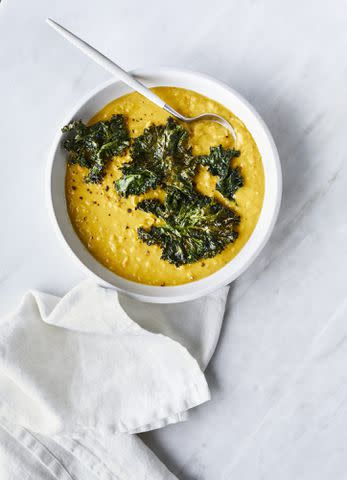
Whether stirred into a nourishing soup, delicious dal, or hearty salad, lentils are a delicious legume that are excellent sources of both protein and fiber. In fact, one cup of boiled lentils contains an impressive 18 grams of protein and 16 grams of fiber.
Whole Wheat Bread
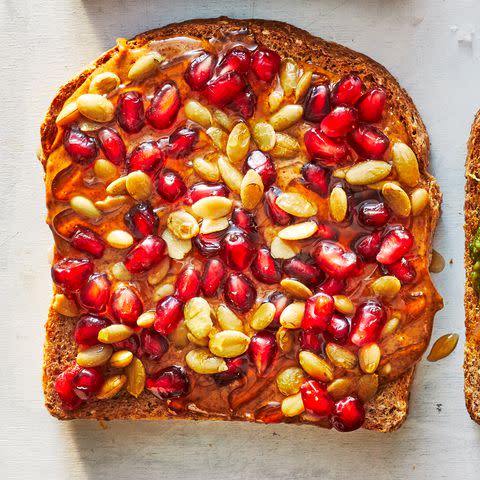
Wheat and wheat products often get a bad rap, but whole wheat, like whole-wheat bread, can provide a noteworthy amount of protein and fiber, especially if it’s made with other grains, nuts, or seeds. Dave’s Killer Bread Organic 21 Whole Grains and Seed Bread, for example, contains five grams each of fiber and protein per slice.
Seeds
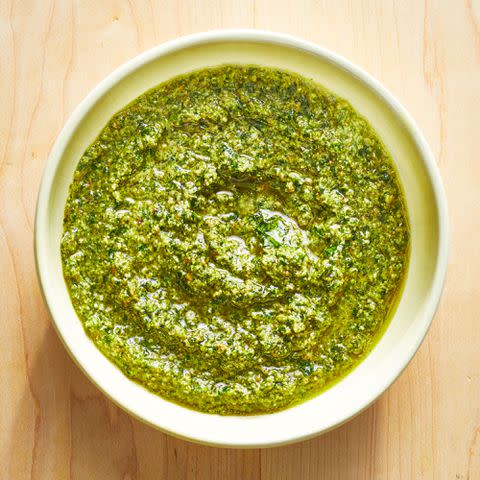
Just like nuts, seeds are packed with nutrients, including fiber and protein. Hemp, flax, chia, pumpkin, sunflower, and sesame seeds are the most popular varieties, and all of them offer these nutritious benefits. For example, in three tablespoons, hemp seeds contain 9.5 grams of protein and one gram of fiber; pumpkin seeds contain nine grams of protein and two grams of fiber; and chia seeds contain five grams of protein and 10 grams of fiber.
Beans
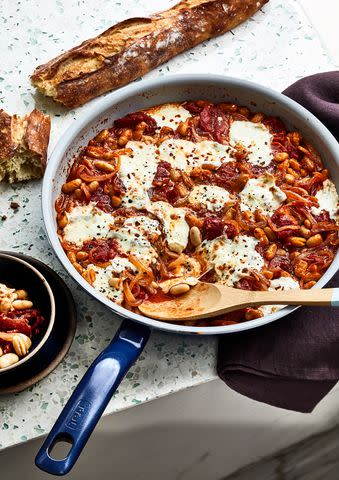
Cheesy Baked Beans and Tomatoes
A cheap, convenient, and versatile protein option, beans offer a one-two punch with plenty of fiber too. In one cup cooked, chickpeas and kidney beans boast 15 grams of protein and 13 grams of fiber, black beans and pinto beans contain 15 grams of each, soybeans an impressive 31 grams of protein and 10 grams of fiber, and navy beans offer 15 grams of protein and 19 grams of fiber.
Brown Rice
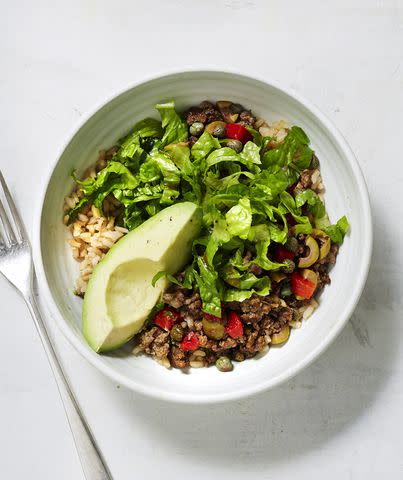
Spanish Beef and Rice Bowls With Avocado
Brown rice is another whole grain that provides a hearty dose of fiber and protein. One cup cooked contains four grams of fiber and five grams of protein. This popular whole grain serves as the perfect soup, stew, burrito bowl, cabbage roll, and stir fry addition.
Peas
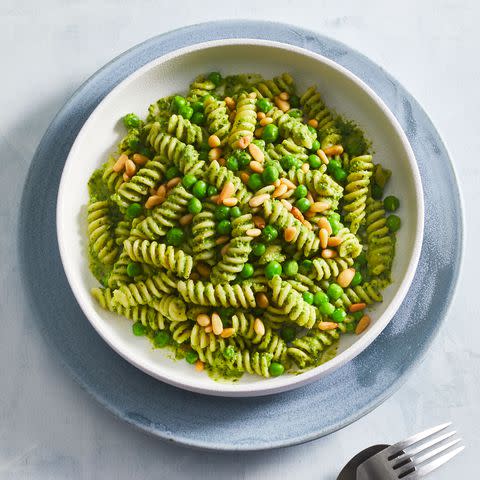
Like other—legumes, lentils and beans—peas are also excellent fiber and protein sources. A cup of raw green peas contains seven grams of fiber and eight grams of protein. This springtime veggie pairs nicely in salads, pastas, soups, savory pies, and dips.
Dark Leafy Greens
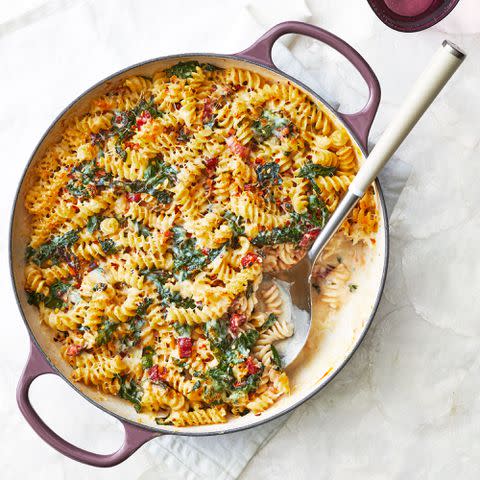
While not often thought of as a meaningful source of protein, you’d be surprised at how much of this macro can be found in leafy greens. In two cups of raw kale, raw spinach, or raw swiss chard, you’ll find nearly two grams of both fiber and protein. These numbers add up quickly given how much these greens shrink down during cooking.
Quinoa
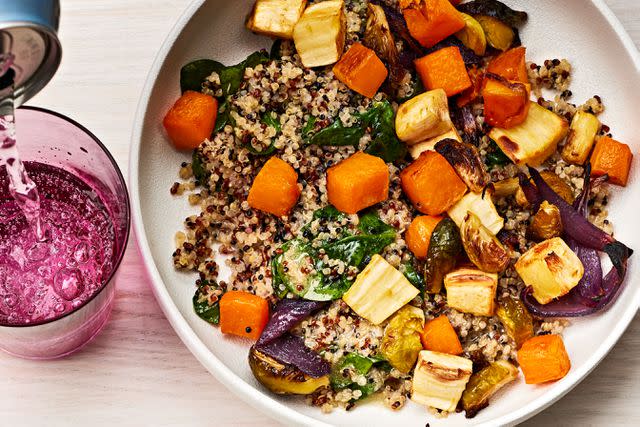
Victor Protasio
Roasted Root Veggie Quinoa Bowls
Though technically a seed, quinoa is often grouped in with the whole grains because it’s prepared and served like other grains. Quinoa consumption has skyrocketed in recent years thanks to its complete protein profile and nutrient density—including fiber, magnesium, phosphorus, manganese, and B vitamins. One cup cooked provides a notable eight grams of protein and five grams of fiber.
Broccoli
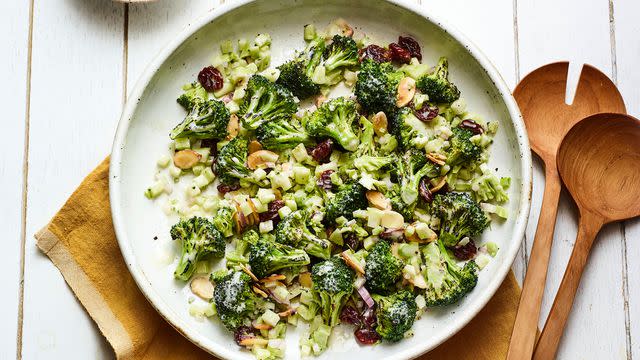
You might be surprised to learn that many cruciferous vegetables offer plenty of protein and fiber. Broccoli is one of the most popular (and most nutritious) cruciferous veggies, with four grams each of protein and fiber in one and a half cups raw. This green veggie is delicious raw in salads and slaws, as well as cooked in soups, pastas, and stir fries—or roasted simply with olive oil, salt, and pepper.
Related: 9 High-Fiber Snack Ideas That Are Healthy, Satisfying, and RD-Approved
For more Real Simple news, make sure to sign up for our newsletter!
Read the original article on Real Simple.

